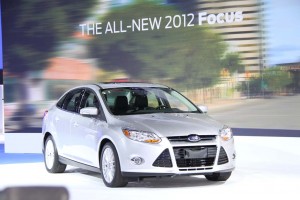
Ford has taken three price hikes this year, one reason it had the highest average transaction price of all major makers in May, analysts report.
There are plenty of reasons why new car sales took a tumble last month – everything from a weak economy to a shortage of some popular Japanese vehicles. But pricing also appears to have been a significant issue, according to industry analysts, with Americans now paying more than ever for new cars, trucks and crossovers.
The average transaction price – what a typical customer actually pays, as opposed to sticker price or the low come-ons you might see advertised – surged to $29,817 in May, according to the data tracking service TrueCar.com. That was up a full $608, or 2.1%, from May 2010 and an increase of $215, or 0.7% over April of this year.
Significantly, prices rose sharply even though many buyers began shifting from larger to smaller vehicles in a bid for better mileage, analysts noted. Traditionally, U.S. motor vehicle prices are closely linked to the size of an automobile.
And while some potential buyers are rethinking their options, used car prices also are heading skyward.
For May, new car “Average transaction prices reached their highest levels ever recorded,” said Jesse Toprak, VP of Industry Trends and Insights at TrueCar.com. “Even though consumers continued to move toward smaller vehicles, they also chose highly contented vehicles that are higher priced, keeping transaction prices high.
Consumers may be adding more content so that the smaller vehicles they are shifting to offer the same level of comfort, safety and performance as the larger models they previously drove.
But there are other factors behind the increase in vehicle costs.
There are, of course, the price hikes that many manufacturers have taken in recent months – manufacturers generally blaming the need to recoup their own cost increases, especially for raw materials, like rubbed and steel. Toyota bumped prices up by about 2% at the beginning of May. Ford Motor Co. has levied three price hikes this year, the latest just this week. (Click Here for that story.)
“Ford is a good example of a manufacturer that diversified its product portfolio to include more fuel-efficient vehicles while increasing market share and transaction prices,” said TrueCar’s Toprak.
The second-largest domestic automaker’s average transaction price, or ATP, surged to $32,885 in May, up 0.5% in just a month, and a full 5.2% from the year before, when customers paid an average $31,257.
At $33,883, General Motors had the highest May 2011 ATP of all the major mainstream manufacturers, but that was only a 1.1% price increase compared to May 2010, and actually was down $37 from April.
Honda had the second-biggest increase, year-over-year, its prices jumping 4.6%, to $25,759, since May 2010 – and 2.6% from April of this year.
The price for Japanese makers, like Honda and Toyota – whose ATP surged to $26,058 last month – also reflect a conscious decision to let prices rise due to increasing product shortages. The two makers alone have so far lost 100s of thousands of units of production due to the earthquake and tsunami that slammed their home market on March 11.
The disaster effectively shut down Japanese auto production for a month, with factories still operating well below capacity. But their foreign-based transplants are also running well below capacity. Toyota’s U.S. plants are completely shut down this week, for example. Honda, meanwhile, said this week it won’t have production of the all-new 2012 Civic up to normal until “sometime in the fall” because of a shortage of parts needed for the compact model.
In particular, Japanese makers have slashed incentives. Toyota’s typical vehicle carried rebates and other givebacks of just $877 last month, down a whopping 54.4% from April’s $1877, according to TrueCar. Honda’s incentives fell 42.3% to an estimated $1,229.
Domestics, too, have been cutting back. General Motors was slammed by industry analysts for the lush givebacks it offered during the first quarter, despite CEO Dan Akerson’s insistence that the strategy paid off in terms of significant gains in sales and market share. So, the maker cut incentives 27.2%, to $2,714, in May.
But that also likely contributed to the maker’s 10% decline in sales last month, though analysts also believe slumping demand for GM’s big, fuel-hungry trucks and SUVs simply wasn’t offset by mounting sales of more fuel-efficient models, like the Chevrolet Cruze.
Having “gone dark” in its marketing efforts, notably including cash come-ons, Toyota Vice President Bob Carter revealed the maker will ramp up incentives in June. And it likely won’t be alone. With May delivering the first significant setback to the industry since late 2009, makers are clearly looking for ways to kick-start demand.
Nonetheless, don’t expect to see them roll back recent price hikes. Indeed, with raw material costs still climbing, the industry has little choice, say industry analysts. And consumers will just have to accept that reality, suggests Deutsche Bank auto analyst Rod Lache, who sees that, over the long-term, the “risk/reward is positively skewed” in the industry’s favor.
“We believe that positive pricing (price hikes) will ultimately be more sustainable than investors expect,” he says, which means average transaction prices are almost certain to keep setting new records.
The increase in new car pricing appears to have many buyers rethinking their alternatives, but used car pricing has also been heading skyward, notes Art Spinella, of CNW Marketing, which may be why demand for previously-owned vehicles also took an unexpected tumble, he reports, last month.

Amazing, for years when every the car Companies raised the cost of the car it was always because of labor cost. No matter what, labor was always to reason they had to raise the cost of the car. Now with labor pay and benefits cut they have to admit the real reason for raising the cost of the car. It’s the raw materials. Maybe the propaganda war between labor and the car business is over.